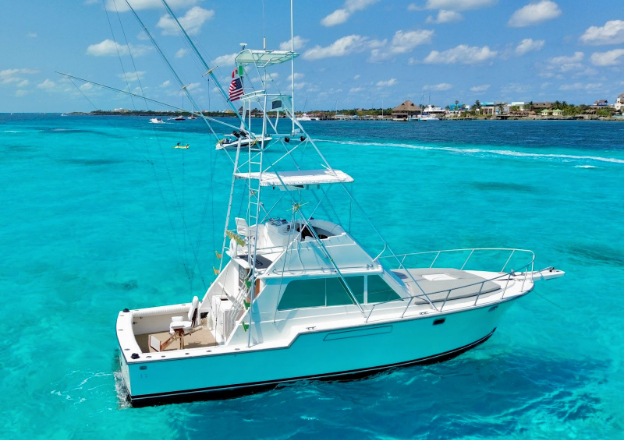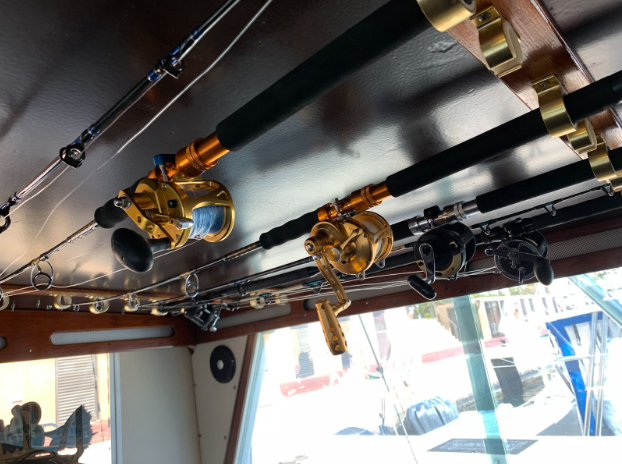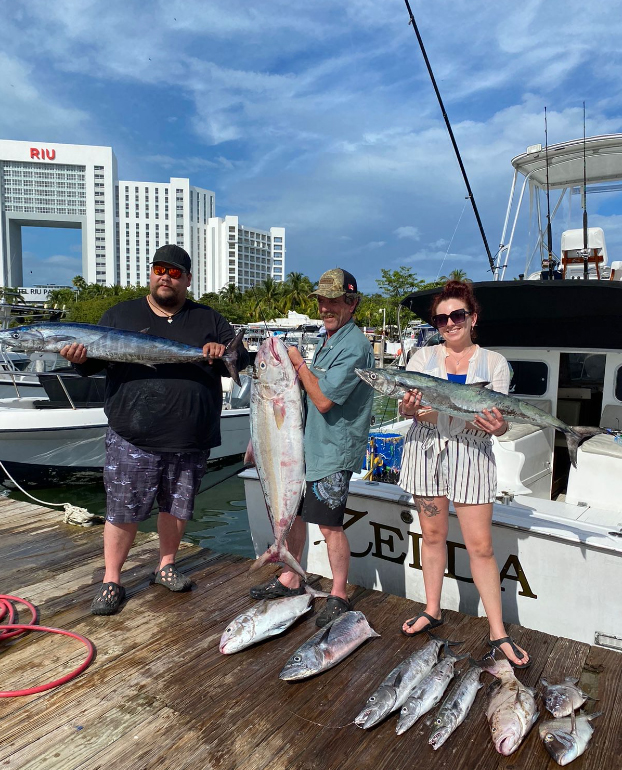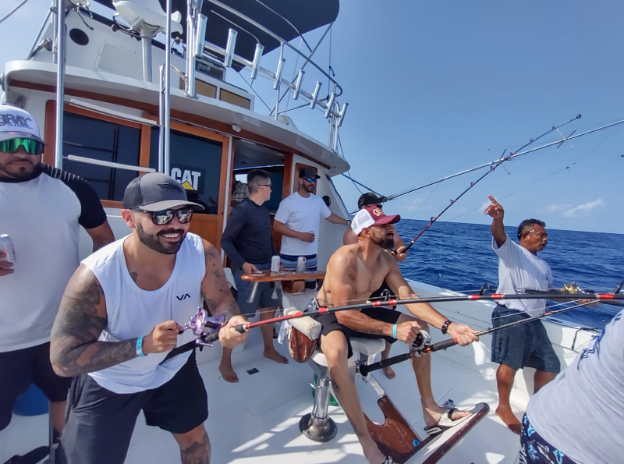Cancun, located at the northeastern tip of the Yucatán Peninsula in Mexico (Latitude: 21.1619° N, Longitude: 86.8515° W), is a world-renowned destination for sport fishing. Situated in the Caribbean Sea, its warm, crystal-clear waters and rich marine biodiversity make it a paradise for fishing enthusiasts. In this region of the Caribbean, the currents of the Yucatán Peninsula and the Gulf of Mexico converge.
With a coastline extending along the famous tourist corridor of the Riviera Maya, Cancun offers privileged access to some of the best offshore fishing spots in the region. Anglers from around the globe flock to Cancun in search of exciting sport fishing adventures. The city boasts a wide range of fishing services, from charter companies and fishing guides to specialized fishing equipment stores.
Cancun International Airport is the second busiest airport in Mexico, after Mexico City, and is undoubtedly the best in the country. It is incredibly easy to fly to Cancun from almost anywhere, especially from the United States and Canada.
The accommodation options are vast, with over 40,000 hotel rooms, Airbnb, hostels, and more in Cancun alone. Additionally, it's possible to stay in the Riviera Maya, the coastal strip between Cancun and Tulum.
The waters around Cancun are known for their abundance of marine species, including sailfish, dorado, marlin, tuna, and wahoo, among others. Both novice and experienced anglers find an unparalleled fishing experience in Cancun. Additionally, Cancun's proximity to stunning coral reefs and productive fishing zones ensures that every Mexico Cancun fishing trip is exciting and rewarding.

The first decision to make when choosing a deep-sea fishing trip in Cancun is how many hours you want to spend on the water. Typically, trips of 4, 6, 8, 10, and 12 hours are offered. Some companies offer 2 or 3-hour packages, but these are almost considered a scams and are not recommended if you want the full experience.
The start time is usually before 7 am, but for 4 and 6-hour trips, you have the option to start as late as 1 pm. A common question is when the trip time starts counting. The clock starts when the boat leaves the dock and ends when it returns. The transfer time from the hotel to the dock is not included in the trip duration.
4 Hours: The shortest trip. This duration is recommended if you are completely new to fishing, have children under 10 years old, or have a very tight schedule. The travel time to the fishing area takes between 45 minutes and 1 hour each way, leaving you with around 2 hours of actual fishing time. You can catch bait, do some trolling, and a bit of bottom fishing.
6 Hours: The most requested duration as it is neither too short nor too long. These trips are recommended for beginners with some prior fishing experience or for those already familiar with the sea. Usually, you start by catching live bait, then trolling, and finally, bottom fishing, though you can focus more on one type if preferred. In this duration, you can reach the "cantiles" (places where the depth changes dramatically) and fish in several spots in the area.
8 Hours: A regular duration for those with more experience, comfortable at sea, or large groups looking to spend time together or celebrate. As with other trips, you start by catching live bait. This is the ideal duration if you want to try catching large species like sailfish and marlin (in season) or a wide variety of species. It’s also possible to make a stop for swimming or spend some time on Isla Mujeres after fishing.
10 and 12 Hours: These durations are reserved for very experienced anglers. These are all-day trips, from sunrise to sunset. You can reach any point in the area, including the ArrowSmith Bank, which is about 1 hour and 45 minutes of navigation from Cancun. Lunch is typically included in these trips, and although it might seem like a long time, for those who love fishing, the time flies by.
https://www.charterfishingcancun.com/boat.html
This is the second important decision to fishing Cancun. There are literally hundreds of boats available for rent in Cancun and the Riviera Maya. The first criterion, obvious as it may seem, is to discard non-fishing boats such as catamarans, sailboats, or yachts with rod holders, as some operators offer snorkeling packages with "a bit of fishing," but this cannot be considered serious fishing.
The second criterion is to determine how many people are in your group. Each boat has a specific capacity, determined by the Port Captaincy, indicating how many people it can safely carry, including passengers and crew. This capacity is stated on a maritime safety certificate and cannot be exceeded; doing so could result in fines or, worse, an accident. So, if you rent a boat for 8 people (plus crew) and end up with 10 people, the captain is within their rights to refuse to go to sea and cancel the trip.
A common question is whether children count as adults, and in this case, yes. The boat's capacity does not differentiate between adults and children.
With that in mind, we can now decide based on more technical aspects about charter fishing in Cancun. Some boats definitely perform much better than others. Without being too scrupulous, the most common brands in the area are Bertram, Cabo, Phoenix, Blackfin, Ocean Yacht, and Rampage, among others. All these boats have twin diesel engines.
Small Boats for 4 People or Less: Notable options include the 31 ft Bertram and the Rampage of the same size. These are excellent boats, spacious, with a bathroom, shaded area, and well-equipped. Their performance at sea is notable, and they are known for being very stable and safe. Ideal for small families or groups looking to fish anywhere in these waters without spending too much money.
Medium Boats for 5-8 People: This category includes the 34 ft Phoenix and the 35 ft Bertram. Classic models with plenty of space, some even with air conditioning and a cabin. Fully equipped, they are excellent options for groups of 8 or fewer.
Large Boats for 10-15 People: The 38 ft Bertram, 40 ft Blackfin, 42 ft Cabo, or the 46 ft Ocean Yacht are the giants of the fleet. Most of these boats are equipped with AC (ask before booking) and have a kitchenette, two cabins, a freshwater shower, and a larger bow for sunbathing. These are excellent for large groups, bachelor parties, families, or those who want more space. The advantage of these boats is that even in bad weather, they can often still go fishing, as port restrictions usually apply to smaller or medium boats.


(https://www.charterfishingcancun.com/about-fishing.html)
There are many types of fishing around the world, with techniques varying by region and country. In Cancun and the Riviera Maya, the following types of fishing are practiced:
Trolling: In this technique, the boat moves while dragging lines on the surface and mid-water. Typically, between 3 and 6 lines are used, depending on the boat, weather conditions, current, and the species being targeted. Common catches include barracuda, dorado, wahoo, mackerel, sailfish, marlin, tuna, and bonito.
Bottom Fishing: This involves stopping over a reef, shipwreck, or hole and dropping lines, usually between 3 and 4, with weights to the bottom. Downriggers and significant weights are used. Typical catches include snapper, grouper, shark, amberjack, and barracuda.
Drifting: In this technique, the boat stops, and lines are extended to drift with surface or mid-water lures. Tuna is often caught this way, but other species such as sharks, sailfish, and barracudas can also be hooked.
Vertical Jigging: Similar to bottom fishing, the boat stops and drops lead lures, mostly reflective with integrated hooks. Light rods are used to create an up-and-down motion that simulates the lures' life. Common catches with vertical jigging include snapper, grouper, and amberjack.
Fly/Spinning Fishing: This type of fishing is done from panga boats that venture into the shallows north of Cancun. It's not deep-sea fishing but rather shallow-water and mangrove fishing with light rods that allow for casting and directing the line. The boats have a capacity for only 2 passengers and the captain. Possible catches include snook, bonefish, tarpon, jack crevalle, sea trout, barracuda, snapper, and more.
At the end of your fishing trip, there are two options for what to do with your catch:

Cancun fish offers opportunities year-round (like barracuda fishing), though many species are seasonal. Online fishing calendars often indicate when specific species are available, but these calendars have become less reliable due to climate change, which has affected the behavior and migration patterns of various species. Here is a general overview of the fishing seasons in Cancun:
Winter: Typically in December, you can catch amberjack, mackerel, wahoo, snapper, grouper, amberjack, and barracuda. This period also marks the beginning of the sailfish migration when sardines arrive in the north with the cooler water. Isla Mujeres is the best area in this part of the year, only 7 miles away from Cancun. This season, extending until early April is ideal for targeting sailfish.
Spring: The fishing becomes productive for pelagic species. Dorado, tuna, wahoo, and mackerel start to arrive. Bottom fishing remains fruitful, with common catches including amberjack, sharks, snapper, barracuda, and amberjack. Grouper fishing is off-limits due to its breeding season from January to April.
Summer: As the water warms up and temperatures easily reach 100 degrees Fahrenheit, it's supposedly the best time for marlin fishing. However, there's been a noticeable decline in blue marlin and, to a lesser extent, white marlin. Dorado, bonito, and tuna continue to be common catches.
Fall: During these transitional months, fishing activity begins to decrease. The frequency of trolling catches drops, and boats focus more on bottom fishing. Despite this, boats still return with fish almost every day. This season also coincides with the rainy season and the potential for storms and hurricanes, necessitating careful planning around weather windows. If there is a time of year when fishing is less productive, it is definitely this one.
When selecting a deep-sea fishing trip from the wide variety of charter companies in Cancun, the minimum your trip should include is:
Some companies, though few. (www.charterfishingcancun.com) also include the following:
What to Bring:
It's a good idea to ask for a written list of what's included in your trip and what isn't. This way, you can avoid surprises such as hidden fees and know exactly what to bring.
The price will depend on the number of hours you want to go fishing, the size of the boat, and the type of boat itself. There is a wide variety of options for all budgets, so the smartest approach is to check several options and compare market prices, taking into account, of course, customer reviews of the charter as well the current conditions of the boat. Keep in mind that vessels with AC are expensive.
You can find very high prices or low prices that seem attractive, but be careful because sometimes cheap can end up being expensive, with hidden costs in some cases. It's better to choose charters that include most of the fees. One fee that is almost inevitable is the dock fee, as it is set by the marinas and not by the boat operators.
For example, some 31-foot boats are advertised at $690 for 6 hours. Sounds like a good deal, right? Then they offer lunch with beer for $40 per person, plus transportation back to your hotel for $58, plus a $24 dock tax and fishing license (assuming you have 2 people). So, a cheap trip of $690 turns into one of $872 USD.
Another frequent question is whether it is better to pay in cash or with a card. In general, cash in dollars is much easier because prices for Cancun activities are set in USD, and you don't have to deal with exchange rates or commissions.
However, in most places, you can pay with a Visa, American Express, or Mastercard. It is very common here to charge a small surcharge for using a card because there are international commissions applied to service providers for receiving funds from another country. Also, keep in mind that the exchange rate is variable, and most of the time, they will apply a local exchange rate (not the one you see on Google, as that one is for wholesale).
Finally, pay methods like Venmo or Bitcoin are not acceptable, yet, in Mexico.
In the Cancun area, there is a vast array of sport fishing companies, independent boats, brokers, etc., with whom you can book fishing services. To choose correctly, you can use the following criteria:
Check Reviews:Use this guide to choose your Cancun fishing charter. Get ready to plan your adventure and experience one of the most exciting water activities Cancun has to offer. Whether you're a solo expert fisherman, with friends, a small or large family, or a group of friends celebrating an event (like a bachelor party), Cancun has plenty of options for you to enjoy this intense activity. It's just a matter of doing a bit of research and booking the best charter for you.
